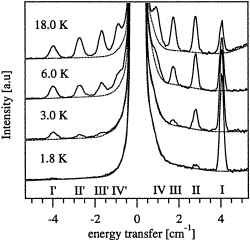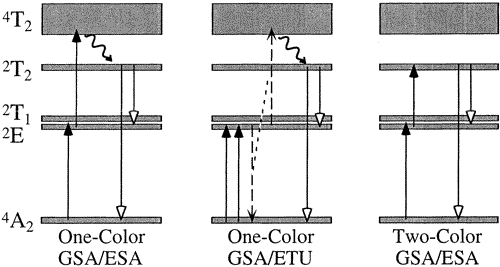Research
Highlights 2000
N. Cavadini, Ch. Rüegg, W. Henggeler, A.
Furrer, H.-U. Güdel, K. Krämer and H. Mutka
Temperature renormalization of the magnetic excitations in
S=1/2 KCuCl3
Eur. Phys. J. B 18, 565-571 (2000)
![]()
![]()
Abstract:
A complete temperature characterization of the spin dynamics in
the unconventional S=1/2 antiferromagnet KCuCl3 is
presented from single crystal inelastic neutron scattering
studies. KCuCl3 features a quantum disordered singlet
ground state and a finite spin gap to triplet excitations of
dimer origin. Three dimensional magnetic correlations support
the dispersive propagation of the excitations in the whole
reciprocal space. Upon increasing the temperature, a
renormalization in the energy, in the intensity and in the
damping rate of the triplet modes is reported. The experimental
observations can be described within the framework of a
selfconsistent dimer RPA theory, with no free parameters. The
driving mechanism behind the model is the thermally activated
decrease of the occupation difference n0-n1
between singlet and triplet dimer states. This is the expression
of kinematic constraints which are of minor importance for
classical magnons in N้el ordered antiferromagnets.
Implications for the temperature dependence of macroscopic
quantities are discussed.
Daniel R. Gamelin, Stefan R. Lüthi and Hans U. Güdel
The Role of Laser Heating in the Intrinsic Optical
Bistability of Yb3+-Doped Bromide Lattices
J. Phys. Chem. B 104, 11045-11057 (2000)
![]()
![]()
Abstract:
Materials displaying intrinsic optical bistability (IOB), i.e.,
allowing the coexistence of two stable steady-state excitation
rates for a single given excitation power, are of interest for
potential technological applications related to optical data
switching and manipulation. The properties of the unusual IOB
previously observed in Yb3+-doped Cs3Lu2Br9
and CsCdBr3 host materials are studied here using
absorption and luminescence spectroscopies. The IOB phenomenon
is concluded to derive ultimately from laser heating effects.
When combined with a strongly increasing and nonlinear
dependence of the material's absorbance on internal temperature,
laser heating leads to a positive-feedback absorption
amplification process showing a hysteresis in both power- and
temperature-sweep experiments. A simple model describing this
effect in terms of rates of sample heating and cooling in the
irradiated volume reproduces the power, temperature,
concentration, and excitation-energy dependence of the Yb3+
IOB using only the experimental absorption data as input. The
temperature dependence of the absorption cross section is
correlated with thermal changes in the monomeric YbBr63-
geometry, which becomes more asymmetric as the temperature is
elevated. The IOB observed in Yb3+-doped Cs3Lu2Br9
and CsCdBr3 host lattices is therefore a property of
the monomeric Yb3+ ion in these materials, and not a
dimer property as was previously believed. These results also
emphasize the more general conclusion that laser heating may
contribute significantly to the shape ore slope of an excitation
power dependence curve, and may even be the dominant aspect of
that curve when absorption cross sections are strongly dependent
on temperature.
 Hanspeter Andres, Reto Basler, Hans-Ulrich Güdel, Guillem Aromi, George
Christou, Herma Büttner and Benoit Ruffl้
Hanspeter Andres, Reto Basler, Hans-Ulrich Güdel, Guillem Aromi, George
Christou, Herma Büttner and Benoit Ruffl้
Inelastic Neutron Scattering and Magnetic Susceptibilities of
the Single-Molecule Magnets [Mn4O3X(OAc)3(dbm)3]
(X=Br, Cl, OAc and F): Variation of the Anisotropy along the Series.
J. Am. Chem. Soc. 122, 12469-12477 (2000)
![]()
![]()
Abstract:
The single-molecule magnets (SMMs) [Mn4O3X(OAc)3(dbm)3]
(X=Br, Cl, OAc and F) were investigated by a detailed inelastic neutron scattering
(INS) study. Up to four magnetic excitations between the
zero-field split levels of the lowest S=9/2 cluster ground-state
have been resolved. From the determined energy-level diagrams
and the relative INS intensities we can show that the inclusion
of a rhombic term in the zero-field splitting (ZFS) Hamiltonian
is essential in these compounds. On the basis of the
Hamiltonian: HZFS = D[Sz2-1/3S(S+1)]
+ E(Sx2-Sy2) + B40O40,
the following sets of parameters are derived: For X = Cl: D =
-0.529cm1, |E| = 0.022cm1, and B40
= -6.5e-5cm1; for X = Br: D = -0.502cm1,
|E| = 0.017cm1, and B40 =
-5.1e-5cm1; for X = OAc: D = -0.4.69cm1,
|E| = 0.017cm1, and B40 =
-7.9e-5cm1; and for X = F: D = -0.379cm1
and B40 = -11.1e-5cm1. The
wave functions derived from the energy analysis are in excellent
agreement with the relative intensities of the observed INS
transitions. The observed temperature maxima of the out-of-phase
component of the variable freqency AC magnetic susceptibility Tmax[chi'']
correlate well with the energy splittings determined by INS.
Direct information about the rate of quantum tunneling is
contained in the cluster wave functions derived in this study.
The difference in the quantum tunneling between X = Cl and Br is
shown to be directly related to differences in the rhombic
anisotropy parameter |E|.
 Daniel R. Gamelin and Hans U. Güdel
Daniel R. Gamelin and Hans U. Güdel
Excited-State Dynamics and Sequential Two-Photon Upconversion Excitation
of Mo3+-Doped Chloro- and Bromo-elpasolites
J. Phys. Chem. B 104, 10222-10234 (2000)
![]()
![]()
Abstract:
The photophysical properties of Mo3+-doped chloro-
and bromo-elpasolites at 10 K and as a function of temperature
are presented. Visible upconverted luminescence is observed with
near-infrared laser excitation, and the properties of this
two-photon excitation process are experimentally characterized
by a variety of luminescence and time-dependent measurements.
Three upconversion mechanisms are active in these Mo3+-doped
materials. Two involve the sequential absorption of two
near-infrared photons of the same color, and a third involves
the sequential absorption of two near-infrared photons of
different colors. The two one-color upconversion mechanisms are
distinguishable on the basis of time dependence measurements and
simulations. Of the three mechanisms, the two-color sequential
two-photon absorption process is found to be more efficient than
the corresponding one-color mechanism by a factor of >102,
and this is related to the relatively small effective spin-orbit
coupling magnitude in this ion. These excited-state processes
are assisted by an extremely long 10 K 2E lifetime of
67.5 ms in 2.5% Mo3+:Cs2NaYCl6,
and 48.5 ms in 2.5% Mo3+:Cs2NaYBr6.
The upconversion properties of Mo3+ presented here
reflect the rich photophysics of this ion, and represent a
significant new addition to the emerging area of
transition-metal upconversion.
E. V. D. van Loef, P. Dorenbos and C. W. E. van Eijk, K. Krämer and H. U. Güdel
High-energy-resolution scintillator: Ce3+
activated LaCl3
Appl. Phys. Lett. 77, 1467-1468 (2000)
![]()
![]()
Abstract:
The scintillation properties of LaCl3 doped with 10%
Ce3+ are presented. Under optical and gamma ray
excitation, Ce3+ emission is observed to peak at 330
and 352 nm. The scintillation light output is 46000+/-1000
photons/MeV at 662 keV. Forty percent is emitted with a decay
time of 26 ns, 30% with 210 ns, and 30% with about 1000 ns. An
energy resolution (full width at half maximum over the peak
position) of 3.3+/-0.3% was observed for the 662 keV full
absorption peak.
![]() Full Text PDF-Files are only accessible from within the University of Bern
Full Text PDF-Files are only accessible from within the University of Bern